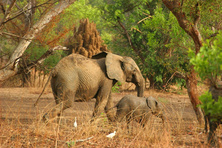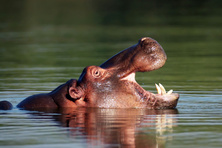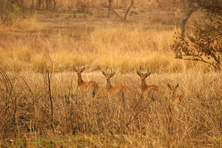Burkina Faso
- Currency: West African CFA franc
- Time: UTC+0
- Languages: French
- Religions: Islam, Christianity, indigenous cults
- Sections: Get in Visa Customs Cuisine Money Details of interest Popular resorts
Burkina Faso is an African state in West Africa. It borders Niger, Mali, Cote D’Ivoire, Togo. And Ghana. The capital city is Ouagadougou.
The climate of the country is sub-equatorial with a dry season, which lasts from November to March. We do not recommend visiting the country from December to February because during this period, dry and dusty wind Harmattan blows making it hard to see and breathe.
The official language in Burkina Faso is French. The population here is practice Islam, Christianity, and indigenous religious rites.
Burkina Faso does not have access to the sea, so it attracts the tourists who like active and interesting holidays. The lovers of nature should visit the Arli National Park, the protected areas Ziniare and Diapaga. In Diapaga, the tourists can go hunting.
The capital city has a lot of monuments and museums and this is the best place to go on excursions. The annual Film Festival and the Show of Arts and Crafts in Ouagadougou make this country a destination for the event tourism. Bobo-Dioulasso is famous for its National Culture Week of Burkina Faso.
The tourists can take a trip to the Archaeological Museum in the city of Djibo and the centre of women’s crafts Gorom Gorom. Anyone can take a picture of harmless holy crocodiles in Koudougou, go fishing on the lake and enjoy the waterfalls in Banfora.
Go to the market in Tenkodogo for a good shopping. This is the capital of the Boulgou province. The foodies will enjoy the local restaurants and a cake shop.
Get in
By Plane
There are direct flights to Ouagadougou from Paris and from Brussels offered by Air France and Brussels. Royal Air Maroc, Lufthansa, and Turkish Airlines offer transit flights from Europe.
CIS citizens need to take transit flights with a transfer in Istanbul, Paris, Munich, Brussels, Frankfurt, and Casablanca. Aeroflot, IUA, Belavia, Uzbekistan Airways and offer transit flights.
By Train
The only international railroad line links Burkina Faso with Cote D’Ivoire. The tourists can take a train from Abidjan to Ouagadougou.
By Land
The tourists can get to Burkina Faso by bus or by car from Mali, Benin, Cote D’Ivoire, and Togo.
Visa
The tourists from the EU and CIS countries must obtain a visa to travel to Burkina Faso. The European Union residents can get a visa on arrival right at the airport.
CIS citizens have to obtain a visa beforehand submitting the documents to the Embassy or the Consulate of Burkina Faso.
The normal time for processing the documents for a visa is seven working days.
Visas are issued for three, six, and twelve months.
You will not be given a visa if you don’t have an international certificate confirming your vaccination against yellow fever.
Customs
The Customs legislation of Burkina Faso does not restrict the transfer of currency through the border, but the money must be declared.
The tourists can bring in the following goods duty-free:
- some alcohol and tobacco;
- clothes, shoes, accessories and personal belongings.
It is strictly prohibited to import:
- meat, plants and food of plant and animal origin;
- pets and cattle;
- certain drugs;
- antiquities and precious metals without a permit.
The travellers are not allowed to export animal skins, ivory and goods made of it, and crocodile skin without a special permit.
Cuisine
The cooking traditions of Burkina Faso will satisfy the taste of both the fans of exotic cuisine and of those who prefer more traditional dishes. The locals eat everything their land gives to them. The main ingredients are snakes, bugs, meat, fish, fruits and vegetables, potato, sorgo, beans and peanut.
The foodies will have a chance to try meat of the monkeys, hippopotamus, snake, antelope, turtle, and even the woodlouse prepared according to the traditional recipe. All the dishes are flavored with a hot sauce Piri Piri. Among the more common dishes are grilled chicken, Poulet Bicyclette, rice with meat and tomatoes Riz Gras and unusual kebabs Brochette.
A slightly bitter porridge To with vegetables, Fufu with corn flour or manioc and sorgo porridge in a pot are common side dishes.
Do not miss a chance to treat yourself to various exotic fruits. The most popular sweet dish among the locals is banana cream with whipped eggs.
Any tourist will be offered a beverage Zoomkoom as a sign of good intent. Yogurt and millet drink Degue and ginger yogurt Yamaku are also very popular.
As for alcoholic drinks, try the local sorgo beer Dolo and palm wine Banji.
Money
The official currency in Burkina Faso is the Central African Frank (CFA). The Central Bank of West African States issues the banknotes from 500 to 10.000 franks and 1 to 500 franc coins.
The tourists can exchange the currency at banks and in special exchange offices which normally work 24 hours. Usually, they are found in touristic areas or in large cities. Exchange the currency beforehand if you are planning to go to a country resort.
Cashless payments are accepted only in hotels in the capital city. The preferred cards are Visa and MasterCard.
The tourists can cash traveller’s checks at banks in Ouagadougou and some other big cities. To avoid additional costs, take the traveller’s checks in French currency.
Due to a complicated criminal situation, the tourists should not travel alone, travel in public transport and leave the documents and valuable things unattended. In crowded places, be very attentive to your personal belongings.
Details of interest
Sightseeing in Burkina Faso
In Burkina Faso, the tourists will be able to see the only UNESCO site and these are the ruins of Loropeni. The ruins of an ancient town are situated close to the Ghana and Togo borders. This is a well-preserved example of a fortifies West African settlement. The protected territory covers 11.130 square meters. There are two versions of the origin of the ruins. The first one says that the palace of Kaan Iya stood in this place. The second legend says that these buildings were used for keeping the slaves. The ruins are divided into several zones by the inner walls built in several rows. Some buildings have only the foundation left and the others are 3 meters high. The houses are situated in the so-called buffer zone around Loropeni and this fact proves that people could process the iron.
In Burkin Faso, there are also seven UNESCO candidate sites and the tourists can see them.
- Those who are interested in history should visit the Necropolis of Bourzanga in the Bam Province.
- The settlement Cour Royale de Tiebele is also of a great touristic interest. The local architecture reflects the traditions of the oldest ethnic group in the country, the Kassena people.
- The lovers of nature should go to the Mare Biosphere Reserve and the Arli National Park.
- Sites of ancient metallurgy for iron reduction in the boose and bwi spaces are also among the UNESCO candidates.
- If you love architecture, do not miss a chance to visit the historic area Sahel and see the Rock engravings of Sahel Burkinabe.
- The Historical centre of Bobo-Dioulasso is of a particular cultural and architectural value. It includes the ancient mosque and the blacksmith neighbourhood.
Learn more about the country visiting the National Museum of Music and the Manega Museum.
Souvenirs in Burkina Faso
- ritual and national masks;
- jewellery with precious and artificial gemstones;
- household items and dishware;
- handmade figurines;
- traditional musical instruments;
- amulets of the local tribes.









